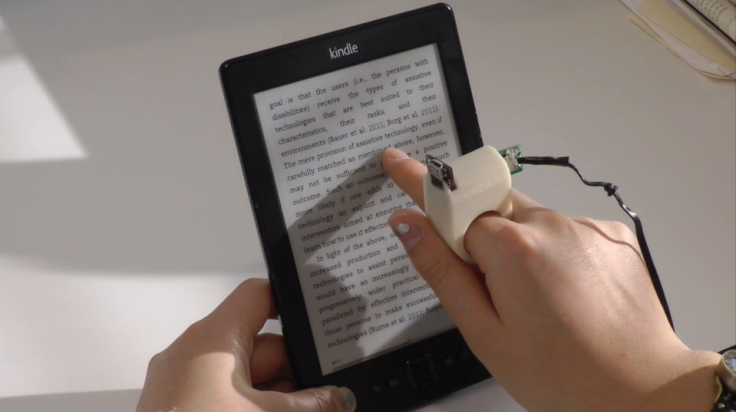FingerReader, Device For The Blind, Reads Text Out Loud With Help From Tracking Finger

You wear it like a ring and it reads to you. The latest whizbang gizmo from the Massachusetts Institute of Technology's Media Lab, the same technology and design group that introduced Sixth Sense, is called FingerReader. And it could be a landmark device for helping blind people or those with visual impairments read without braille.
The benefits of FingerReader extend far beyond reading books (although that is pretty astounding in its own right). The device is meant to be used in just about every context in which people find themselves reading: restaurants, hospitals, at work, around the house. Researchers behind the project, the results of which they published in a recent report, say FingerReader could be the affordable and user-friendly solution to a problem that affects over 11 million people.
From an end-user standpoint, the device is simple. It slips over your index finger like a ring, and with the help of a camera pointed at the text, you glide your finger across the page as a synthesized voice reads the words aloud. Three years of coding and various test groups have honed a set of vibrating sensors, which alert you when you stray from the line and when you hit the end of a line. For many, the supreme benefit will be the translation capability that occurs in real time.
“Everywhere we go, for folks who are sighted, there are things that inform us about the products that we are about to interact with. I wanna be able to interact with those same products, regardless of how I have to do it,” Jerry Berrier, 62, told The Associated Press. Berrier was born blind. He manages training and evaluation for a federal program that gives technology to low-income people with visual impairments living in Massachusetts and Rhode Island.
FingerReader isn’t available to the public yet. To do that, says co-researcher Dr. Roy Shilkrot, would mean getting the device to work on touch-screen devices, such as tablets and e-readers. Right now, the only solution is disabling the touch recognition component of the device; keeping everything on FingerReader the same, the user’s finger is likely to disrupt the movable text.
Unlike other devices for the visually impaired (VI), which scan words in chunks before vocalizing them, FingerReader picks up words immediately. As the researchers point out, it “presents a new way for VI people to read printed text locally and sequentially rather than in blocks like existing technologies dictate.” Up next is a more robust study designed to test the device’s effectiveness.
FingerReader - Wearable Text-Reading Device from Fluid Interfaces on Vimeo.
Published by Medicaldaily.com



























